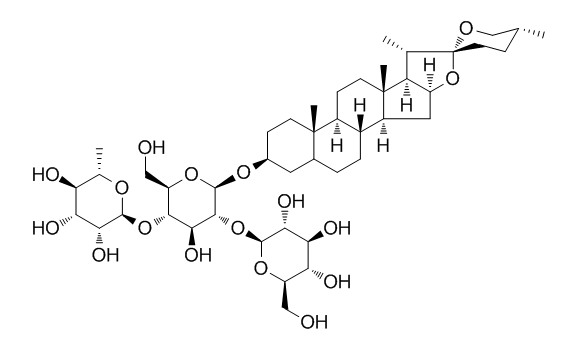Shatavarin IV
Shatavarin IV shows in vitro anti-malassezia activity. Shatavarins (containing shatavarin IV) rich fraction (AR-2B) exhibits significant anticancer activity in both in vitro and in vivo experimental models.
Inquire / Order:
manager@chemfaces.com
Technical Inquiries:
service@chemfaces.com
Tel:
+86-27-84237783
Fax:
+86-27-84254680
Address:
1 Building, No. 83, CheCheng Rd., Wuhan Economic and Technological Development Zone, Wuhan, Hubei 430056, PRC
Providing storage is as stated on the product vial and the vial is kept tightly sealed, the product can be stored for up to
24 months(2-8C).
Wherever possible, you should prepare and use solutions on the same day. However, if you need to make up stock solutions in advance, we recommend that you store the solution as aliquots in tightly sealed vials at -20C. Generally, these will be useable for up to two weeks. Before use, and prior to opening the vial we recommend that you allow your product to equilibrate to room temperature for at least 1 hour.
Need more advice on solubility, usage and handling? Please email to: service@chemfaces.com
The packaging of the product may have turned upside down during transportation, resulting in the natural compounds adhering to the neck or cap of the vial. take the vial out of its packaging and gently shake to let the compounds fall to the bottom of the vial. for liquid products, centrifuge at 200-500 RPM to gather the liquid at the bottom of the vial. try to avoid loss or contamination during handling.
Chemistry of Natural Compounds2019, 55(1):127-130
Dent Mater J. 2024, dmj.2023-294.
Horticulturae2020, 6(4),76.
Korean J of Pharmacognosy2020, 51,49-54.
Int. J. Mol. Sci.2022, 23(14),7699;
Evid Based Complement Alternat Med.2018, 2018:1073509
Molecules.2021, 26(16):4722.
J Pharm Biomed Anal.2019, 172:268-277
Front Immunol.2018, 9:2655
Korean J. Medicinal Crop Sci.2021, 29(6):425-433
Related and Featured Products
International journal of cosmetic ence, 2013, 36(1):74-78.
In vitro Anti-Malassezia Activity and Potential Use in Anti-dandruff Formulation of Asparagus racemosus.[Reference:
WebLink]
Malassezia species are frequently associated with dandruff and seborrhoeic dermatitis. The study was conducted to evaluate anti-fungal activities of the extracts obtained from the roots of Asparagus racemosus Willd against Malassezia furfur and M. globosa.
METHODS AND RESULTS:
Asparagus racemosus roots were successively extracted with the series of solvents, that is, hexane, ethanol and water, and also a saponin-enriched fraction was prepared. The amounts of saponin (equivalent to Shatavarin IV) in the extracts were determined using ELISA. The extracts were tested for anti-fungal activity by disc diffusion and broth microdilution methods. By disc diffusion, only the ethanolic and saponin-enriched extracts demonstrated anti-fungal activity against M. furfur and M. globosa at the concentration of 1 mg per disc whereas the extracts with other solvents were ineffective. Multiple concentrations using the broth microdilution method against M. furfur and M. globosa yielded minimum inhibitory concentrations (MICs) of 25 mg mL(-1) for the ethanolic extract but much higher potency for the saponin-enriched extract: MICs to 0.20 and 0.40 mg mL(-1) for M. furfur and M. globosa, respectively. These extracts showed no antagonist effect with the anti-fungal agents, ketoconazole and zinc pyrithione.
CONCLUSIONS:
These studies revealed the antifungal activity of A. racemosus roots extracts. Because A. racemosus is also anti-inflammatory agent, it has the potential use as an active ingredient in an anti-dandruff formulation.
Indian Journal of Pharmacology, 2012, 44(6):732.
Shatavarins (containing Shatavarin IV) with anticancer activity from the roots of Asparagus racemosus.[Reference:
WebLink]
The anticancer activity of shatavarins (containing Shatavarin IV) isolated from the roots of Asparagus racemosus (Wild) was evaluated using in vitro and in vivo experimental models.
METHODS AND RESULTS:
The Shatavarin IV was isolated from ethyl acetate insoluble fraction (AR-2B) of chloroform:methanol (2:1) (AR-2) extract of A. racemosus roots. The cytotoxicity (in vitro) of Shatavarin IV and other shatavarins rich fraction was carried out using of MTT assay using MCF-7 (human breast cancer), HT-29 (human colon adenocarcinoma), and A-498 (human kidney carcinoma) cell lines. The in vivo anticancer activity of shatavarins (containing Shatavarin IV) was evaluated against Ehrlich ascites carcinoma (EAC) tumor bearing mice. The isolated Shatavarin IV (84.69 %) along with shatavarins rich fraction, coded AR-2B containing 5.05% Shatavarin IV showed potent cytotoxicity. Oral administration of AR-2B to tumor bearing mice at doses of 250 and 500 mg/kg body weight for 10 days, showed significant reduction in percent increase in body weight, tumor volume, packed cell volume, viable tumor cell count, and increased non-viable cell count when compared to the untreated mice of the EAC control group. The restoration of hematological parameters towards normalcy was also observed.
CONCLUSIONS:
The result suggests that the shatavarins (containing Shatavarin IV) rich fraction (AR-2B) exhibits significant anticancer activity in both in vitro and in vivo experimental models.
Natural product communications, 2012, 7(8):995-998.
Furostanol Saponin and Diphenylpentendiol from the Roots of Asparagus racemosus.[Reference:
WebLink]
METHODS AND RESULTS:
A new furostanol steroidal saponin, shatavaroside C (1), and a new diphenylpentendiol, shatavarol (2), together with five known compounds, Shatavarin IV (3), racemoside A (4), beta-sitosterol (5) stigmasterol (6) and ursolic acid (7), have been isolated from the roots of Asparagus racemosus.
CONCLUSIONS:
This is the first report on the isolation of racemoside A (4) from roots of the plant. Structures of isolated compounds were determined on the basis of detailed analysis of their 1D, 2D NMR and mass spectral data.



